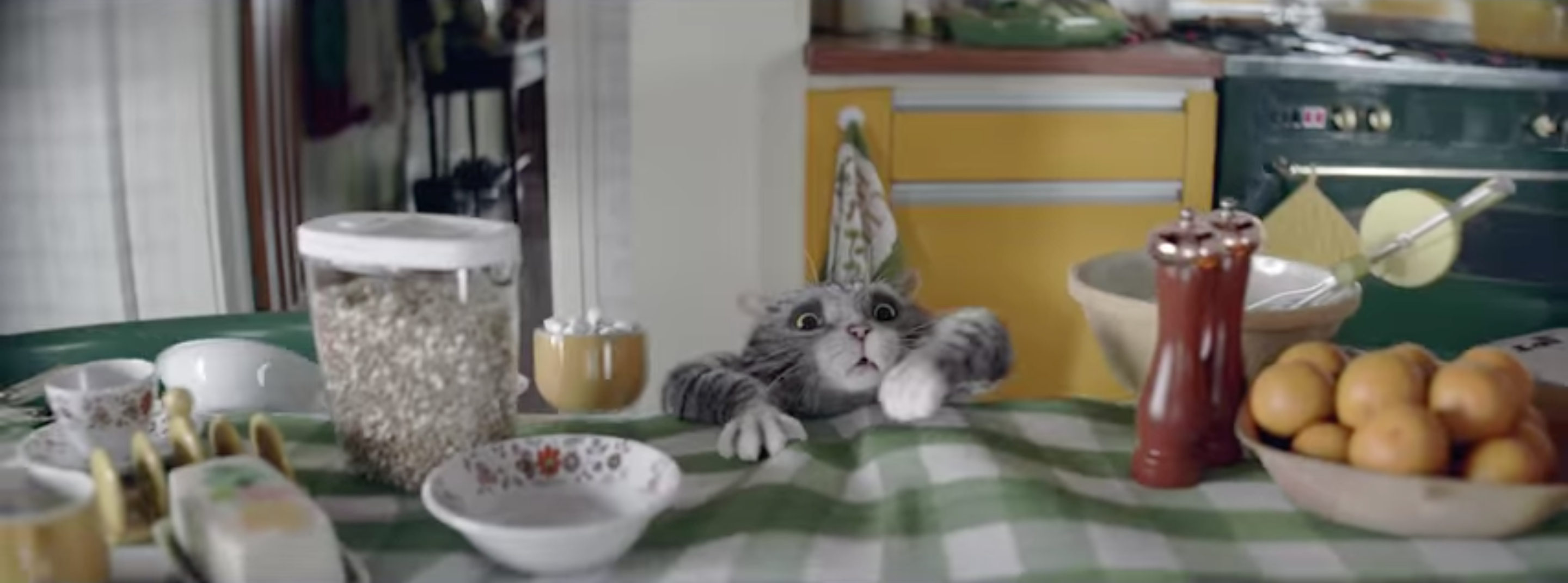As if the crisp chill in the air, increasing wattage of fairy lights and introduction of gin baubles (yes, really, this is not a drill) wasn’t enough of a giveaway, the arrival of Christmas 2016 has officially been heralded by several hours worth of new festive adverts. Forget that sap Monty the Penguin, motheaten Mog the Cat and the slightly-too-melancholic Man on the Moon, this year’s seasonal stars have landed and stolen the nation’s fickle hearts away, ready to get people spending.
However, amongst the trampolining dogs, mutilated carrots (very festive Aldi) and animated characters revelling in the ‘simple joy of giving’, Christmas adverts of the last five years contain very few actual products. Far from being a visual gift list for children to commit to memory and pester parents about for weeks, adverts have become feature length, cinematic spectaculars that result more in increasing warm fuzzy feelings, than sales of warm fuzzy slippers.
Unsurprisingly, this is deliberate. What is surprising however, is the significant effect that doing so has had on consumer habits. John Lewis, the undisputed, twinkling star on the tree of festive adverts estimates that since 2012, sales have increased more than 35% due to its Christmas advertising. It’s also no coincidence that 2012 saw the first of the company’s big budget, hotly anticipated slush fests (we all remember the journey of the hapless snowman set to Frankie Goes to Hollywood’s Power of Love right?)
This particular method of marketing is an example of brands attempting to create ‘customer affinity’. The hope is that the warm fuzzies that meticulously crafted, heartwarming tales generate will cause the customer base to fall in love with the brand they emanate from, and subsequently use it as this year’s gift supplier. If we take three of 2016’s biggest Christmas ads in isolation, we can clearly see this at work:
- “Buster the Boxer” by John Lewis
The department store behemoth has reverted to type this year by using cute, fluffy animals to cut quickly and efficiently to the heart of every viewer. There’s no time for creating a complex human narrative for JL – those mounds of Orla Kiely crockery and reduced ‘Monty’ plush toys from 2014 ain’t gonna sell themselves. As well as the now famous Buster, the advert also features a wealth of woodland creatures (who, it is worth noting, would be natural predators and prey outside the idealised world of festive advertising) bouncing in harmony atop poor Bridget’s new trampoline. ‘Give gifts that everyone will love’ ties the whole concept together, and when combined with Buster’s soulful eyes and a moody, indie cover of One Day I’ll Fly Away, you’d have to have the heart of The Grinch and the ethical compass of Philip Green not to be hit right in the feels.
However you feel about this year’s offering, John Lewis have undeniably been at the pioneering helm of Christmas advert marketing for the last five years. You need only give twitter a cursory scan around mid November to see just how anticipated their televisual production is, and 2016’s advert has been accompanied by more hype-generating events and accoutrements than ever before. JL have not only created a new microsite for the advert to be hosted on, they also hosted in-store, virtual reality experiences, whereby awed customers can watch the animals trampolining in 3D. With such an onslaught of experiential, abstract branding, JL have made it difficult, nigh on impossible, not to view the company as a major and key component of the festive season.
Sellable products featured: 1 – the hallowed trampoline
Customer affinity rating out of 5: 4
- “The Greatest Gift” by Sainsbury’s
It’s pretty obvious what Sainsbury’s are doing in their festive ad. Train delays? Check. Overworked city dweller? Check. Just wants to get home to his family? Check. It’s the modern-day A Christmas Carol with Southern Rail starring as Scrooge. Yes, there are some glaring logistical issues with this ad, not the least of which being why the main character doesn’t just use his train delay time to order his gifts online, but the message is one that we’ve all been relating to since Chris Rea got stuck in that traffic jam – Christmas is for spending with the ones you love. Whilst stuffing down as many Quality Streets, mince pies and Bailey’s as your Sainsbury’s trolley could contain of course.
Sellable products featured: Technically none – the advert is animated
Customer affinity rating: 3.5
- “With Love from Mrs Claus” by Marks & Spencer
Despite endless stories of store closures and cutbacks, M&S have still managed to create the most blockbuster-esque, big budget advert of all, stuffed full of special effects and visual spectacular. The story depicts Mrs Claus kiss her husband goodbye as he sets off to deliver gifts around the world, before using a snow-ski and helicopter to transport a pair of special shoes to a little brother who has some ‘splainin to do. As much as the adventures of Mrs Claus can (and have) been described as a feminist call-to-arms, the relatable and emotive aspect of the advert is really carried by Anna and her little brother, who set aside their arguments to show each other they care at Christmas. This scenario has been designed to trigger personal memories in its audience, and is arguably the most engaging out of all the brands’ attempts to do so this year. Perhaps M&S could have saved themselves several million if only they’d realised this sooner.
Sellable products featured: Two – mince pies (which are not demonstrably from M&S, but Mrs Claus surely wouldn’t accept anything less) and Anna’s sparkly, red, peacekeeping shoes.
Customer affinity rating: 4.5
In the age of social media, where the customer has more frequent and closer access to the brand than ever before, it is unsurprising that Christmas marketing has morphed and transformed to reflect this. Products, it is assumed, will sell themselves. It’s stories, emotions and customer affinity that will tempt the product buyers in. The reason for this is simple: if people feel marketed to, they are resistant. If they feel emotionally invested in a brand, they have been marketed to without knowing it. Merry Christmas!


















